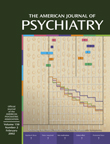Transcranial Magnetic Stimulation for Panic
Ms. A, a 52-year-old woman, had been suffering from panic disorder (according to DSM-IV criteria) with six panic attacks per week for 13 months. She had not received any prior treatment and was medication free at the time of admission. Ms. A gave her informed consent for treatment after the procedure had fully been explained to her; she was treated in a pilot investigation with slow rTMS of the right dorsolateral prefrontal cortex for 2 weeks (10 sessions, 1200 stimuli/day, 1 Hz, 110% intensity, which was related to individual motor threshold). At baseline and after rTMS treatment, a CCK-4 challenge was performed to assess the putative effects of rTMS in its ability to induce panic attacks. Panic symptoms were assessed by applying the Acute Panic Inventory (4) and the Panic Symptom Scale (5). Cortisol and ACTH plasma levels were determined during the challenge. Ratings for general anxiety and naturally occurring panic attacks were assigned after use of the Hamilton Anxiety Rating Scale and Bandelow’s Panic and Agoraphobia Scale (6).After 2 weeks of rTMS, Ms. A reported a marked improvement in her anxiety. Her score on the Hamilton anxiety scale had decreased from 27 to 6 (–78%), and her score on the Panic and Agoraphobia Scale had decreased from 34 to 14 (–59%). Moreover, a marked reduction in her CCK-4–associated panic symptoms was observed after the second challenge. Her maximum scores on the Acute Panic Inventory and the Panic Symptom Scale decreased from 34 to 20 (–41%) and from 38 to 26 (–32%), respectively. Her maximum serum cortisol level CCK-4 challenge decreased from 884 nmol/liter to 0 nmol/liter; her maximum serum ACTH level decreased from 1.47 pmol/liter to 0.35 pmol/liter. At her 4-week follow-up examination, Ms. A’s condition was stable, so she did not require further pharmacotherapy.
References
Information & Authors
Information
Published In
History
Authors
Metrics & Citations
Metrics
Citations
Export Citations
If you have the appropriate software installed, you can download article citation data to the citation manager of your choice. Simply select your manager software from the list below and click Download.
For more information or tips please see 'Downloading to a citation manager' in the Help menu.
View Options
View options
PDF/EPUB
View PDF/EPUBGet Access
Login options
Already a subscriber? Access your subscription through your login credentials or your institution for full access to this article.
Personal login Institutional Login Open Athens loginNot a subscriber?
PsychiatryOnline subscription options offer access to the DSM-5-TR® library, books, journals, CME, and patient resources. This all-in-one virtual library provides psychiatrists and mental health professionals with key resources for diagnosis, treatment, research, and professional development.
Need more help? PsychiatryOnline Customer Service may be reached by emailing [email protected] or by calling 800-368-5777 (in the U.S.) or 703-907-7322 (outside the U.S.).

